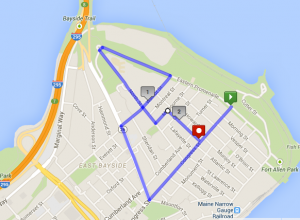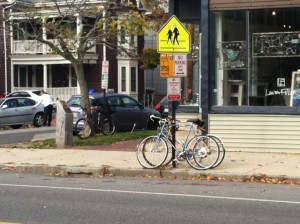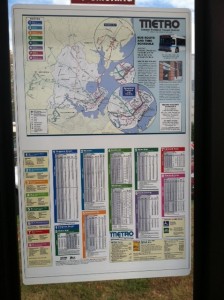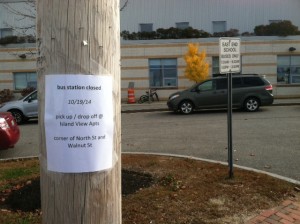Transect Walk
Munjoy Hill Area
October 19, 2014
Started at Eastern Promenade and Congress Street. Walked up Congress Street.
Almost every block along Congress Street had at least three bicycles outside houses or on the street. The bicycles locked on the sidewalk were usually locked to sign posts or trees. There were almost no bike racks and the bike racks that existed had room for at most two bikes. There were no bus stations along this section of Congress Street despite it being both a residential and commercial area (there were a lot of cafes). Though there were bus stops along Congress, no buses were seen.
Right on Washington Avenue.
Despite having many restaurants with good food and a surprisingly diverse food selection, the actual street looked dilapidated, largely due to the run down roads and unkempt sidewalks. There were no bike lanes and the shoulders were not particularly accessible because of the parked cars. The roads were not in good condition.
Right on Walnut Street.
The street is much more residential than Washington Ave., but the roads were still rather run down. There were still plenty of bikes outside houses but no bike lanes.
Left on Eastern Promenade.
There is some sort of bicycle road race for adults and another course for children. It looks like the race is almost over. It was pretty crowded and there were a few food trucks. Further down the Eastern Promenade is deserted probably because the road is closed for the race. There is a school which we stopped by to find some mental maps. A few families with small children and someone walking their dog. The school playground was relatively deserted.
Left on North Street.
We walked by a bus stop with seating and a rain cover. There was a large map and schedule for bus routes. However, there was a paper flyer stating that the stop was closed. The stop was by a church and a school and a few blocks from a residential area. There were a lot of cars parked at the intersection of North and Eastern Promenade and there seemed to be a lot of people in the church. There was a family packing/unpacking family bikes into a car.
Left on Melbourne Street.
Melbourne Street took us back into a residential neighborhood. Again, I did not notice the bus stops and there were no bike lanes but still a few bikes outside. The roads were a little nicer than those along Washington Avenue.
Right on Merrill Street.
Still a rather residential area. I did not see any bus stops or buses along the road.
Right on Congress Street.
Went to Hilltop Cafe. The few blocks had to the cafe had already been walked.
The transect walk confirmed what was said about the public transportation system in Portland. There were few bike lanes or bike racks despite every block having a number of bikes locked outside houses or to street signs. The easier suggestion would be to increase the number of bike racks to make the city more aesthetically pleasant and to encourage biking around the city. Since biking on the sidewalk is usually dangerous for pedestrians and bikers, it would be nice if there were more bike lanes or at least larger shoulders for the streets. The only bike lane I noted was along parts of Congress Street. However, the city does seem to be encouraging bikers as the day I visited Portland part of the Eastern Promenade had been closed for road races for adults and children. There are also nice trails along the water by the Eastern Promenade.
The more accessible and perhaps useful alternative form of transportation is the bus system that, based on my transect walk, is severely lacking. I saw very few active busses and could only find one schedule of routes and stops. The schedule attached to the bus stop did not have hours for Sunday. Instead there was a note at the bottom that stated, “Limited holiday, weekend, evening and Sunday Service,” suggesting the unreliability and inaccessibility of the transportation system. There was then a paper note stating that the bus stop was not running that day although that might have been for the aforementioned road race. Though the map showed that a few bus lines went into neighboring areas such as Westbrook and Falmouth, there were hardly any actual bus stops on these routes making the bus system seem largely ineffective. Though it would be a large investment to increase the number of routes, stops, and hours, three out of my four mental map people mentioned that the public transportation system was lacking, and one emphasized especially for senior citizens.





The issue of public transportation in Portland has been recurrent in multiple blogposts and mental maps by other people. The fact that this issue comes up so often means that it affects both residents and people who live around Portland. I feel the need for better public transportation every time I go to Portland because I do not have a car. I think it would also be great if there were more transportation options from places around Portland, like Brunswick, because a lot of people commute there to work. Introducing available public transportation for residents and commuters would also greatly contribute to reduced carbon emissions. I think biking would also be a great alternative for people who want to give up on cars, so the city of Portland should also look into improving infrastructure for alternative modes of transportation.
Your thoughts on the public transportation system in Portland are shared by myself and many others in our class. Something clearly needs to be done about transportation around the city for people without cars. I love your idea of having more bike racks; I had considered the possibility of building more bikes lanes in the city, but bike racks are also incredibly important for bicyclists. Do you think there are any areas in particular that are in more dire need of bike lanes and bike racks than others? The man I interviewed near Old Port in the Post Office Plaza told me that Portland didn’t need more bike lanes, but perhaps he was only referring to that part of the city.
I also agree with Kote that transportation to and from Portland could be improved drastically. It’s always surprised me that there aren’t more options for getting to and from the city considering how many people from nearby cities and towns commute there every day.
Your walk shows the issues with public transportation in the city. The clear major issues with the influence of the public sector over the residents is the public transportation. The unfortunate weather in Portland seems to be very problematic for any type of transportation. Bike lanes seem to be of highest needs/ could influence the whole transportation system if the public space was friendlier for them. The issue again is the unfortunate weather 70% of the time.
I agree with some of the other comments who say that bike lanes are a seasonal solution. Better public transport needs to be available year round and in a place with as much snow and cold weather as Portland, bikes cannot compete. Bike lanes seem like a huge investment for something that is guaranteed to be seasonal. Each road would need to be widened or the driving lanes shrunk by several feet in order to create the bike lanes. All that is very expensive and potentially dangerous with very narrow lanes for cars.
a better bus system does seem like a massive problem. As many people have pointed out, Portland needs more consistent routes and better signage to go along with it in order to make the system more attractive to commuters. I imagine the problem right now is mostly with cost. Running buses with low ridership is a massive expense. I wonder if they could contract the routes to make them more cost effective. You mentioned that there were few routes to Falmouth so I wonder if anyone ever takes them. I feel like they could just cancel that route and save a ton of money driving several miles with very few stops.
I really enjoyed your ideas from the transect walk. As I found in my walk as well, Portland is severely lacking in reliable and frequent public transportation and bike accessories such as bike paths and bike racks. Furthermore, you mention that although you managed to find some bus stops, you did not see a single bus on your two and a half hour walk – we did not see any busses either. Your ideas about Portland’s wilting public transport system remind me about the Sorkin reading about the hierarchy and flow within a city. That the flow, the creation and feeling of the journey from place to place, is designed to make personal automobiles (not public transportation busses or bikes) have the most efficient journey; this sheds light on not only the frustration likely felt by Portland public transport commuters or bikers but also on Portland’s (possibly unintentional) transportation priorities as a whole.
I also made note of the bicycle storage situation, albeit on the other side of the city. Its interesting to see that, while many people are using bikes nowadays, there is little civic encouragement for them to do so. They do not have dedicated bike paths, there are almost no bike racks to store them at, and as a result their usage and storage of these eco-friendly transportation devices is both a nuisance to their time efficiency and the city’s overall appearance. Luckily, bike racks are a much cheaper fix than bike lanes, as well as far more easily installed into the city fabric, and would be an easy fix for the city of Portland to invest in. Bike racks, in encouraging the movement away from the use of cars to get around the city, are in a sense both a sustainable and “smart” form of intervention at a basic urban level.